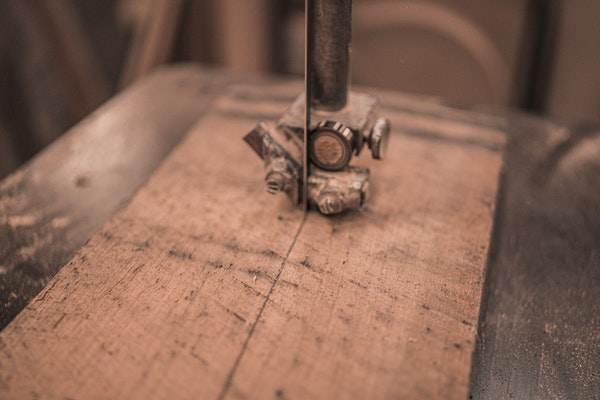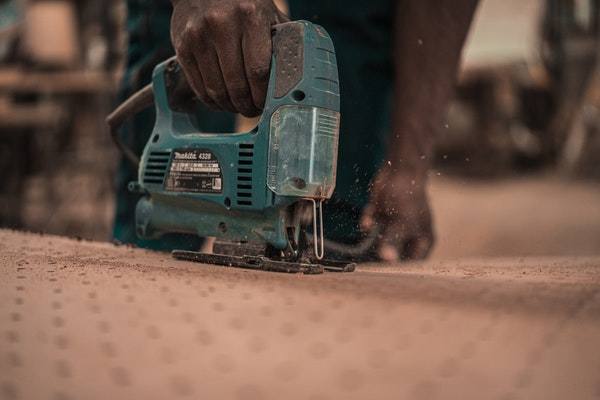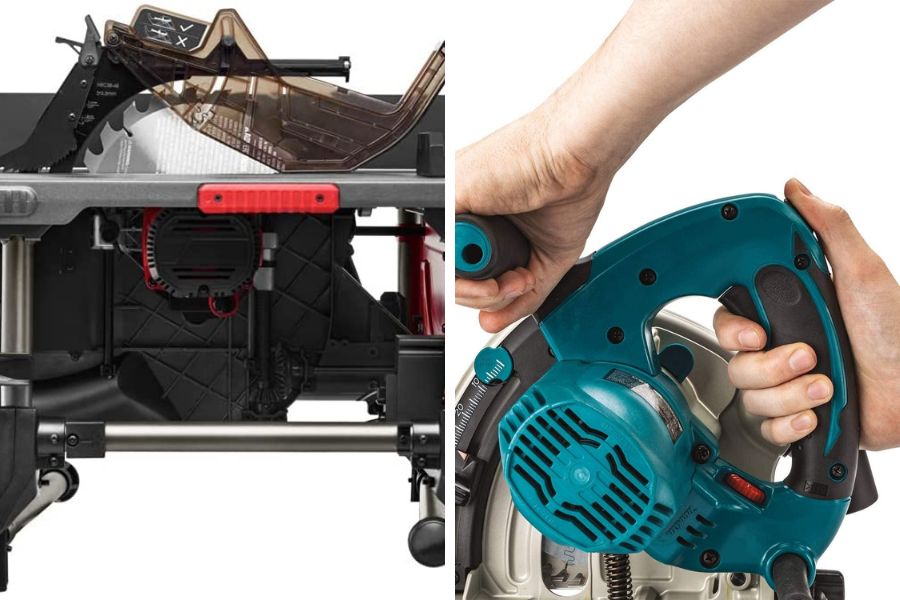You’ve got to choose the right tools for your workshop and there are many to choose from. Sometimes you have to make a decision based on portability or versatility and other times, you simply need something solid and reliable to handle specific tasks.
You can find any number of circular saw blade options out there. Some of them you will find are handheld while others may be on a table or a stand of their own. In the end, you choose tools based on your needs and what the different tools can do for you. You also will probably need more than one type of saw for your workshop so keep in mind that you may need more than one option in the future.

In this guide, we are going to take a look at the table saw vs track saw and compare just what these saws have in common as well as how they are different. All of this will hopefully provide you with some clear insight as to what you might prefer on your job site – or whether you even need both.
Let’s take a look!
Table of Contents
Circular Saw Comparison: Track Saw Vs Table Saw
What you will find in this track saw vs table saw comparison is that while these circular saws are both designed to be very different, they are very similar as far as capability and overall functionality. They do not look the same because the track saw is made to be a handheld saw while the table saw clearly is on a table and actually sports a table as part of the design.
Both of these can make deep cuts, straight cuts, rip cuts, smooth cuts, and more. We’re here to distinguish between the two and let you know just how they are similar but also how they are different.
Table Saw

Let’s start with an overview of the table saw and then we will move on to track saws. Table saws are perhaps one of the most popular saws out there on the job site, as well as in any woodworker’s shop. This is because they are known to be versatile and capable of massive cutting capacity while being safe and simple to work with.
The table saw is a circular saw with a rotating blade and generally a riving knife before the blade. Most table saws have a blade guard in place to help prevent mishaps. They are known for making accurate and clean cuts but also being able to cut in a hurry.
There are a lot of different styles of table saws out there, including cabinet saws, contractor saws, hybrid saws, and portable table saws. These other saws are all met with the same design concept but they might be made to handle more durable or sturdy materials than the traditional saw.
How It Works
Table saws are a versatile tool. Any number of tool reviews will let you know that you can rely on this powerful cutting machine to achieve accurate cuts. You have adequate power to be able to work with thick hardwood for ripping boards but you can achieve a number of other purposes as well.
The table saw works using an electric motor. The motor is powerful and loud most of the time. It’s not uncommon to get some kickback or wood debris so it’s always a good idea to wear appropriate safety gear as well. The blade of the table saw is set into the table surface. and it rotates in a circular motion.
Where the track saw has a fully exposed blade, the table saw will have blade guards or even a covered blade to some degree. Of course, this is set up in a way as to not hinder the blade while you work. These saws also typically have a dust collection system to try to help with the mess and when you compare table saws vs track saws, this is something you will find to be different between the two.
A table saw can be used for sheet goods, to cut lines, and even make repeatable rip cuts or plunge cuts as needed but it can be limited in some ways. It is on a static table so you won’t be able to squeeze it into tight spaces or harder to handle sizes and materials. Some of those narrow rip cuts or repetitive cuts or even sheet goods may be better suited to a track saw on the job sites.
When to Use a Table Saw
The table saw is great for a number of things. You can get a decent cut depth but probably not quite as deep as the track saw vs the table saw. If you’re working in a fixed location and you want a higher motor power, the table saw is here for you.
Table saws can handle most materials just fine. You can use it for ripping lumber, a dado stack, some miter saw uses, and even just simple straight cuts. When you compare the track saw vs table saw, you will find that they can do almost all of the same things but they take up different amounts of space for the work they are doing.
Here are the most common things to use a table saw for.
- Repeatable rip cuts
- Rip multiple identical widths
- Repetitive cuts
- Miter cuts
- Rough cut or ripping
- Straight edge cuts with the fence
- When dust collection is a must
You can make precise cuts of all kinds and you can work in coordination with a miter gauge for most of these. You can easily find a table saw that can be used on job sites.
Table Saw Pros and Cons:
No machine is perfect for every little thing, although some may come closer than others. Let’s take a look at the pros and cons of a table saw.
- Table saws can make precise cuts
- The table saw can handle tough and thick materials
- Table saws have dust collection systems generally
- A table saw is versatile
- A table saw can rip wood quickly
- You can make repetitive cuts on a table saw
- Easy to use
- Table saws are built to be powerful
- Takes up more space
- Not as easily portable, unless you purchase a portable table saw
- Will require setup on a jobsite table or similar surface
- A dust port is not guaranteed
- Your purchase includes one Dewalt table saw, 10inch 24-tooth carbide blade, rolling stand, push stick, miter gauge, rip fence, 2x blade wrenches, blade guard assembly manual
- Other Specs: Max rip to left of blade – 22inch | Max rip to right of blade – 32-1/2inch | Max width of Dado – 13/16inch | Arbor size – 5/8inch | Amps – 15 | Depth of cut at 45inch – 2-1/4inch | Depth of cut at 90° – 3-1/8inch | No Load Speed: 4800 RPM
- Rolling stand designed for easy set up and breakdown with excellent stability
- Rack & Pinion Telescoping Fence System Make fence adjustments fast, smooth and accurate
- Features a 15.0A high torque motor with the power to cut pressure treated lumber and hardwoods
- RACK AND PINION FENCE RAILS - Ensures fence stays parallel to blade for fast smooth, and accurate cuts
- INTEGRATED FOLDING STAND - Legs quickly fold in to provide portability and convenient storage
- PARALLEL BLADE ALIGNMENT - Available micro-adjustment of blade so that it is parallel to rip fence and miter slot
- 4x4 CUTTING CAPACITY - Cuts material up to 4x4 at 90 degrees
- 2-47° BEVEL CAPACITY - Cuts between 2 positive stops at 0 and 45 degrees with quick release lever
- COMPACT BUILD - Conserve storage space and simplify transporting this tool with a compact design
- ACCURATE ADJUSTMENTS - Make fast, smooth fence adjustments with rack and pinion telescoping rails
- PROFESSIONAL RIP CAPACITY - Take on large jobs with 24.5 in. of rip capacity for ripping 4X8 plywood or OSB sheets
- SITE-PRO MODULAR GUARDING SYSTEM allows for tool-free adjustments of the guarding
- POWER-LOSS RESET prevents accidental restarts following a power disruption when the tool is left in the on position
Track Saws

You will find that a lot of tool reviews might tell you that you can replace a table saw with a track saw. And while that may be true in some things, just keep in mind that you may not be able to completely replace it because there are places where one may work better than the other.
The only constraint of a track saw is that you won’t have your guides or your fence when you work so while you might have these versatile tools with sizable cutting depth, you don’t have the steady table or surface to guide you fully along with the cut.
The track saw is a handheld saw that can be great for crosscuts or long rips, particularly if you have a wide board or surface, like a full sheet good of metal or plywood. Track saws operate with a quality track, which is more like a guide rail. This is a circular saw with its own track. You can make precise cuts but you can also make incredibly deep cuts which are perhaps one place track saws stand out in table saw vs. track saw comparisons.
How It Works
The track saw is known for the tracks of the saw, which help to make smooth and clean cuts. The tracks hold the track saw in place so that you get the exact point and cuts that you need using the track saw. You set the track saw to align and you never have to worry about it losing course or slipping so there are fewer mistakes.
Track saws sometimes have a dust port but it can vary from device to device. It really depends on the track saw. If a dust port or collection system is important always be sure to watch for this detail. The track saw is a circular saw so it sports a circular saw blade that rotates just like a table saw does.
Track saws and table saws work very similarly, they just have a different build. You will also find that a track saw uses sticky rubber strips. These can help with staying on track so you get identical cuts that are precise as they should be without getting off track.
Track saws can be really useful for narrow cuts as well as plunge cuts because they can hit a better depth overall and they can fit into more challenging and narrow spaces as well.
When to Use a Track Saw
Track saws are all about straight cuts and we mean they are designed for the perfectly straight approach. You can certainly achieve this on a table saw as well but you get just a bit more stability and you don’t have to worry about the wood moving while you’re cutting. The table saw straightness is only as reliable as the solidity and stability of the fence really.
When you’re in a tight or narrow space, turn to track saws. When you need steady stability for a full sheet or major depth or plunge, turn to track saws. These are great examples of when the track saw may be your best option and can stand out against the table saw overall.
Tack saws are handheld and lightweight. This might make them more versatile in some regards. Sometimes they will have dust cleanup and sometimes they won’t so again this is something to look for if it is essential to you.
We like track saws for their versatility. You might also be able to save yourself some material and even time in some respects. You can easily take your track saw just about wherever you may need it at the time. It’s far more portable in comparison to a track saw.
Track Saw Pros and Cons
Just like with the table saw, you will find that track saws aren’t always perfect. Let’s discuss some pros and cons of the track saw to give you the big picture.
- Always precise and smooth when cutting
- The track saw sometimes offers dust collective systems
- Extremely portable for any odd needs
- Great for narrow spaces or cuts
- Perfect for plunged cuts or angles
- The track saw is a good option for full sheets
- Known for its stability for precision
- The track saw has less power to it
- Getting set up and working can take a lot more time
- Stabilization and lining up is key to accuracy
- The Festool TS 55 is not your standard circular saw. The saw rides on a guide rail, or track, providing accuracy and versatility allowing it to replace the world's most advanced cabinet saws, miter saws and panel saws. The TS 55 track saw delivers precise, splinter free, glue ready cuts and only takes seconds to setup. Breaking down sheet goods? Cuts at an obscure angle? No longer is there a need to design a complex jig or move heavy material to your large shop equipment.
- The TS 55 track saw works seamlessly with it's integrated rail, available in various sizes. Utilize the rail and saw with or without a table or work surface. The track saws flat housing allows for flush cutting.
- Concentrated torque and up to twice as fast work progress with an increased saw blade service life.
- Virtually splinter-free on both sides thanks to attachable splinter guard.
- The cutting edge from 90° to 47° remains unchanged even when the saw bevels.
- 12 AMP motor with variable speed control dial (2,000 - 5,200 RPM) for optimum performance in a variety of materials
- Large cutting capacity (2-3/16" at 90° and 1-9/16" at 45°). Power Type- Corded
- Bevel capability (-1 to 48°) with positive stops at 22.5° and 45°
- Makita SP6000J1 6-1/2" Plunge Circular Saw Kit, with Stackable Tool case and 55" Guide Rail
- Powerful 12.0 AMP motor for optimum performance in a wide variety of materials
- Ditch the table saw: rip boards up to 2-1/3 inches thick with clean, splinter-free cuts
- Create 45-degree bevel cuts in boards up to 1-5/8 inches thick
- Perfect for ripping boards or for performing internal plunge cuts
- Includes a 6.5-inch 24-tooth carbide-tipped blade (165 mm) with a 20 mm arbor
- Compatible with the WEN CT9502 100-Inch Track and the WEN CT992F Track Saw Clamps
Choosing Between a Track Saw and Table Saw
Now that you know the basics of each of these saws, let’s talk just a little bit about how you might differentiate between them or even choose between them if that is your goal here. As you’re perusing whether you want a table saw, a track saw, or both, consider these criteria.
Power
The power between these two items is significantly different. The table saw is strong and powerful and while a track saw is certainly not weak, it doesn’t have as much power as the other. This will be significant to keep in mind if you work with harder or rougher materials.
While your track option might be easier to work with in some cases, it might not have enough power to really deliver the results you’re after. If you want speed and power, you need to stick with table saws for this particular specification.
Portability
While the table saw can be portable in some cases, if you really want the most out of portability, you are going to find that more likely with the track saw. There are portable table saws out there so if you still need power, then you might need to consider those. Otherwise, the track saw might suit your needs.
This portable machine can be very useful for cutting materials on site or handling full sheets of materials. They can also come in handy when you find yourself needing to cut in a more narrow or awkward space so the track saw is the winner in terms of portability.

Safety
Luckily, both of these saws have safety mechanisms in place. If you want the ultimate safety means possible, a track saw does have more safety behind it and has a track record for fewer injuries, particularly severe injuries.
Table saws do have some safety mechanics in place but they are more limited and most definitely not a fail safe. There are more known injuries related to table saws on the market and that is simply because of the exposed blade and the power behind it.
However, if you operate using all safety protocols, either saw can be safe. Remember that these are power tools and injury can occur if you are not absolutely careful every step of the way.
Versatility
The good news is that both of these machines can be pretty versatile. You may want to consider specifically the types of cuts and the locations of those cuts more than anything else.
Keep in mind that the table saw can be useful for rip cuts, fast cuts, powerful cuts, and even repetitive cuts. If you’re looking for absolutely stability and precision, or even cutting angles and narrow spaces, go ahead and go with your track saw for the best results.
Conclusion
Both the table saw and the track saw can be useful in their own ways. They have a lot of similarities and can handle a lot of the same things as well. While they both specialize in different areas, you need to consider what will be most useful or efficient for your own purposes to make a decision.
We’re curious! Which one will you be adding to your tools?
Amazon Recommends:
- 12 AMP motor with variable speed control dial (2,000 - 5,200 RPM) for optimum performance in a variety of materials
- Large cutting capacity (2-3/16" at 90° and 1-9/16" at 45°). Power Type- Corded
- Bevel capability (-1 to 48°) with positive stops at 22.5° and 45°
- Makita SP6000J1 6-1/2" Plunge Circular Saw Kit, with Stackable Tool case and 55" Guide Rail
- Powerful 12.0 AMP motor for optimum performance in a wide variety of materials
- The Festool TS 55 is not your standard circular saw. The saw rides on a guide rail, or track, providing accuracy and versatility allowing it to replace the world's most advanced cabinet saws, miter saws and panel saws. The TS 55 track saw delivers precise, splinter free, glue ready cuts and only takes seconds to setup. Breaking down sheet goods? Cuts at an obscure angle? No longer is there a need to design a complex jig or move heavy material to your large shop equipment.
- The TS 55 track saw works seamlessly with it's integrated rail, available in various sizes. Utilize the rail and saw with or without a table or work surface. The track saws flat housing allows for flush cutting.
- Concentrated torque and up to twice as fast work progress with an increased saw blade service life.
- Virtually splinter-free on both sides thanks to attachable splinter guard.
- The cutting edge from 90° to 47° remains unchanged even when the saw bevels.
- Includes a powerful 10-Amp 6.5-inch plunge cut circular saw with 24-tooth carbide-tipped blade and adjustable cutting depth up to 2-1/3 inches. Create 45-degree bevel cuts in boards up to 1-5/8 inches thick.
- Comes with two 50-inch universal track saw guides with adapters and rubber lip for dust control. Make straight cuts over 8 feet long.
- Adapter set features 4 set screws for maximum stability when using the tracks.
- Circular saw base features precision grooves to slide smoothly along the track.
- Bundle compatible with WEN CT992F Track Saw Clamps (sold separately).






